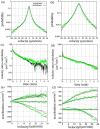Functional analysis of spontaneous cell movement under different physiological conditions
- PMID: 18612377
- PMCID: PMC2444018
- DOI: 10.1371/journal.pone.0002648
Functional analysis of spontaneous cell movement under different physiological conditions
Abstract
Cells can show not only spontaneous movement but also tactic responses to environmental signals. Since the former can be regarded as the basis to realize the latter, playing essential roles in various cellular functions, it is important to investigate spontaneous movement quantitatively at different physiological conditions in relation to a cell's physiological functions. For that purpose, we observed a series of spontaneous movements by Dictyostelium cells at different developmental periods by using a single cell tracking system. Using statistical analysis of these traced data, we found that cells showed complex dynamics with anomalous diffusion and that their velocity distribution had power-law tails in all conditions. Furthermore, as development proceeded, average velocity and persistency of the movement increased and as too did the exponential behavior in the velocity distribution. Based on these results, we succeeded in applying a generalized Langevin model to the experimental data. With this model, we discuss the relation of spontaneous cell movement to cellular physiological function and its relevance to behavioral strategies for cell survival.
Conflict of interest statement
Figures




References
-
- Bray D. Cell movements: from molecules to motility. New York: Garland publishing; 2000.
-
- Ueda M, Sako Y, Tanaka T, Devreotes P, Yanagida T. Single-molecule analysis of chemotactic signaling in Dictyostelium cells. Science. 2001;294:864–867. - PubMed
-
- Sato MJ, Ueda M, Takagi H, Watanabe TM, Yanagida T, Ueda M. Input-output relationship in galvanotactic response of Dictyostelium cells. Biosystems. 2007;88:261–272. - PubMed
-
- Dormann D, Weijer CJ. Chemotactic cell movement during Dictyostelium development and gastrulation. Curr Opin Genet Dev. 2006;16:367–373. - PubMed
Publication types
MeSH terms
LinkOut - more resources
Full Text Sources
Other Literature Sources

